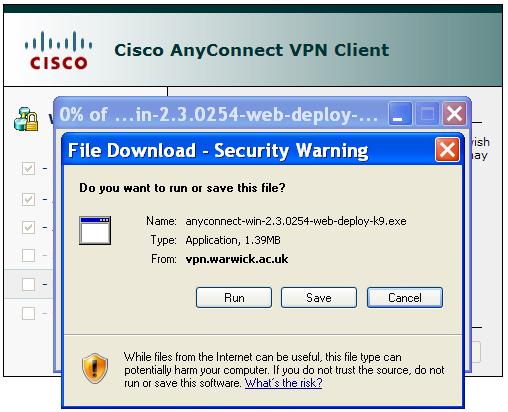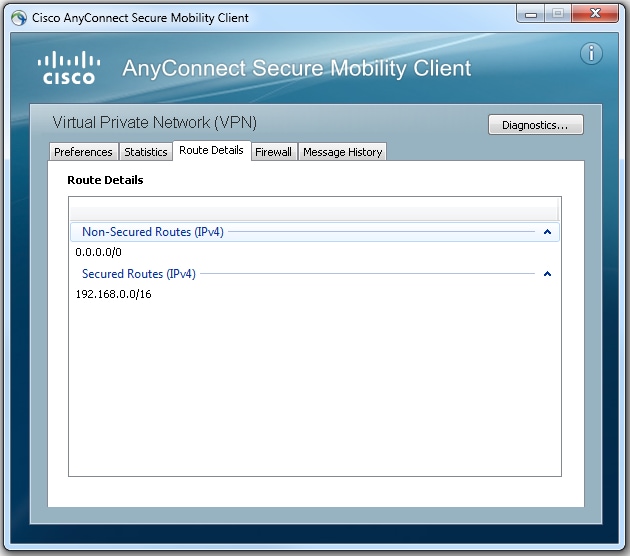

- #Cisco vpn setup download how to#
- #Cisco vpn setup download full#
- #Cisco vpn setup download password#
Then browse to the object properties > attribute editor > find distinguished name If you are not familiar with distinguished names, I suggest you enable advanced views in dsa.msc and then go into the attributes of your object, the distinguished name will be there. Now go back, edit your LDAP server group, and set the LDAP attribute MAP that we just created as the one for that server group.Īlso, here’s a screenshot of the group and user I used for the LDAP connection and attribute map. Doing this means that any user of that group gets assigned the group policy of “RemoteUsers” which we will create later. Then set the cisco attribute to “RemoteUsers”.
#Cisco vpn setup download full#
Put the FULL DN of the AD group that will have remote VPN users in it. Then head over to the mapping of attribute value tab and click add

Name it “anyconnectLDAP” set the attribute to memberOf and the Cisco attribute to GroupPolicy and click add. Of course replace the IP with your AD server’s IP.ĭon’t forget to test your server, click Test which is the last item in the right column and enter domain creds to test. We first need to create the LDAP server group and attribute MAP for our connection profile.Ĭlick ok and then click “add” in the bottom server group tabįill out the following page, don’t forget to create a service account for the ASA. Then Upload your image, finally click okay once it’s autoselected. Do this by clicking yes to the prompt about designating the anyconnect image. Then enable the following:Īlso, select the “enable cisco anyconnect VPN…” and upload the. Head over to the configuration, Remote Access VPN tab. Great now let’s go back into ASDM so we can configure Anyconnect. Here are the network objects and NAT rule.Ĭonfiguration > Firewall > objects > network objects Let’s first create the NAT rule necessary to facilitate communication with our LAN and the Client VPN subnet.
#Cisco vpn setup download how to#
Now here’s how to do all of this from the GUI/ASDM. Split-tunnel-network-list value SPLITSUBNETĪnyconnect image disk0:/anyconnect-win-7-k9.pkg 1 Tunnel-group “SDCUsers” webvpn-attributesĪccess-list SPLITSUBNET standard permit 10.0.1.0 255.255.255.0 Tunnel-group “SDCUsers” general-attributes Tunnel-group “SDCUsers” type remote-access Map-value memberOf CN=RemoteUsers,CN=Users,DC=sdc,DC=local RemoteUsers Ldap-login-dn CN=administrator,CN=Users,DC=SDC,DC=LOCAL EnableĪaa-server RALDAP (inside) host 10.0.1.10 The only thing you won’t see in here is configuring an A record or the SSL cert for the client VPN. Nat (inside,outside) source static LAN_PRIVATE LAN_PRIVATE destination static CLIENTVPN_PRIVATE CLIENTVPN_PRIVATE no-proxy-arp You will also need the following NAT Rules to facilitate communication between local and client VPN subnets. "Anyconnect image disk0:/anyconnect-win-7-k9.pkg 1" either add your own image from the GUI guide, or replace reference your own image. "Access-list SPLITSUBNET standard permit 10.0.1.0 255.255.255.0" Replace with your internal subnet(s) for the split tunnel traffic.

"CN=RemoteUsers,CN=Users,DC=sdc,DC=local RemoteUsers" the DN of the Group allowed to VPN into the network.
#Cisco vpn setup download password#
" " The Password to the service account above. "CN=administrator,CN=Users,DC=SDC,DC=LOCAL" with the domain admin service account for your ASA, the DN of it. "DC=SDC,DC=LOCAL" with the base DN of your Domain, my domain was SDC.LOCAL Replace the following below with your own: "10.0.1.10" with your AD/DNS Server I will be showing both the ASDM/GUI and CLI commands. I recommend the GUI method once, then use the CLI once you understand it. This article will discuss setting up Cisco Anyconnect with LDAP/Domain Authentication.


 0 kommentar(er)
0 kommentar(er)
